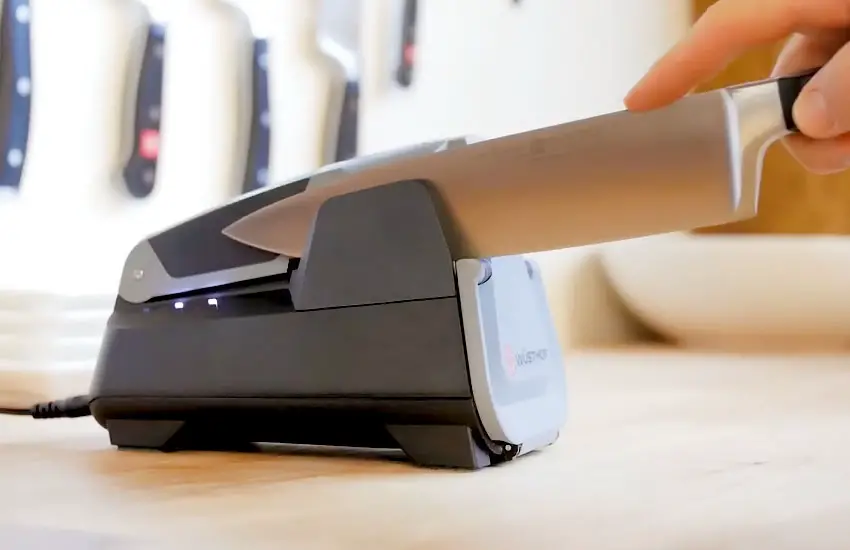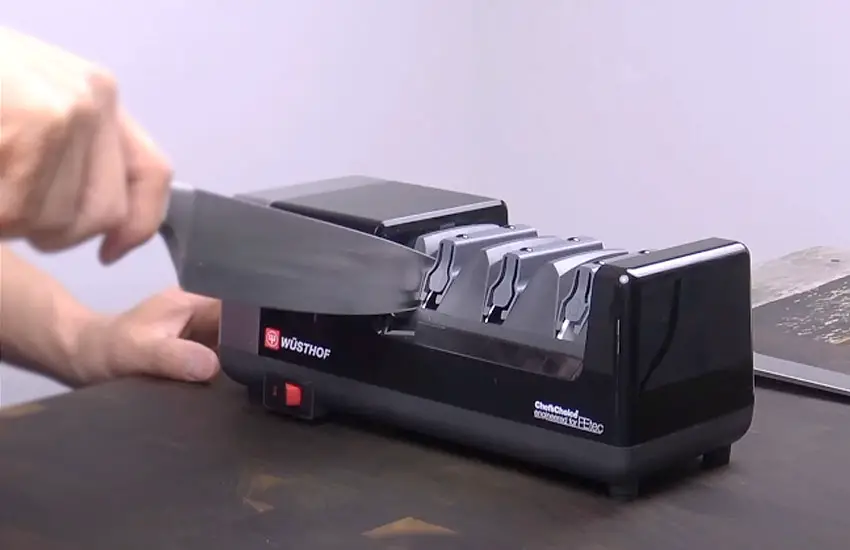As an Amazon Associate, I earn from qualifying purchases at no extra cost to you.
How to Use Wusthof Knife Sharpener: Easy Steps
Do you want to keep your kitchen knives sharp for effortless slicing and dicing? If so, learning how to use a Wusthof knife sharpener is essential. Wusthof knife sharpeners are handy tools designed to make sharpening knives easy and effective.
In this guide, we’ll explore the simple steps you need to follow to keep your knives in top condition. From understanding the sharpener to mastering the technique, you’ll discover everything you need to know to make your kitchen tasks smoother and safer.

Understanding Your Wusthof Knife Sharpener
Before you start sharpening your knives, it’s important to understand your Wusthof knife sharpener. Wusthof offers different types of sharpeners, including manual and electric ones. The manual sharpeners usually have two or three slots with different levels of abrasiveness. These slots are where you’ll place your knife to sharpen it. Electric sharpeners, on the other hand, are more automated and can sharpen knives quickly with less effort.
No matter the type, all Wusthof sharpeners have similar components. They typically include abrasive materials like diamond, ceramic, or carbide, which help to grind and sharpen the blade. Some sharpeners also have a honing steel, which helps to straighten the blade and maintain its edge between sharpenings.
Understanding the components of your sharpener is crucial for achieving the best results. Before you begin sharpening, take a moment to familiarize yourself with how your sharpener works. Read the instructions carefully and identify the different slots and their purposes. This will help you use the sharpener correctly and avoid any potential mishaps.
Additionally, it’s essential to know the condition of your knives before sharpening them. Check for any chips, nicks, or damage to the blade that may require professional attention. Sharpening a damaged knife could worsen the problem and affect its performance.
Preparing Your Knife for Sharpening
Before you start sharpening your knife with a Wusthof sharpener, it’s important to get it ready. Here’s what you need to do:
First, make sure your knife is clean and dry. A dirty or wet knife won’t sharpen properly and could damage the sharpener.
Next, inspect your knife for any damages, like chips or nicks, on the blade. If you find any, it’s best to get them fixed by a professional before sharpening.
Once your knife is clean and free of damage, you’re ready to begin sharpening. But remember, safety comes first! Always handle your knives carefully to avoid accidents. Hold the knife securely and keep your fingers away from the blade while sharpening.
By preparing your knife properly, you’ll ensure that you get the best results when sharpening with your Wusthof sharpener. So take the time to clean, inspect, and handle your knife safely before you start sharpening.
Using the Wusthof Knife Sharpener
Using a Wusthof knife sharpener is easy, and with a few simple steps, you can sharpen your knives quickly and effectively. Here’s how to do it:

Step 1: Positioning the Sharpener
Before you begin sharpening your knife, find a stable surface to place the Wusthof sharpener on. It’s essential to have a steady base to prevent any accidents while sharpening. Make sure the sharpener is secure and won’t slip or slide during use.
Step 2: Holding the Knife at the Correct Angle
Once the sharpener is in place, it’s time to hold the knife correctly. Most Wusthof sharpeners are designed to sharpen knives at a specific angle, usually around 20 degrees. To achieve the correct angle, hold the knife steady and position it at the designated angle as indicated by the sharpener’s instructions. Some sharpeners may have guides or markings to help you maintain the proper angle.
Step 3: Drawing the Knife Through the Sharpening Slots
With the knife held at the correct angle, carefully draw the blade through the sharpening slots of the Wusthof sharpener. Start at the heel (the widest part) of the blade and slowly move towards the tip. Apply gentle pressure as you pull the knife through the slots, ensuring that the entire length of the blade makes contact with the abrasive materials inside the sharpener.
For manual sharpeners with multiple slots, start with the coarsest slot and work your way through to the finer slots for a smoother finish. Repeat this process several times until you achieve the desired level of sharpness.
Step 4: Repeat as Necessary
Depending on the condition of your knife and the level of sharpness you’re aiming for, you may need to repeat the sharpening process multiple times. Check the blade periodically to assess the sharpness and adjust as needed. Remember not to over-sharpen the knife, as this can lead to excessive wear and tear on the blade.
Step 5: Honing (Optional)
Some Wusthof sharpeners may also include a honing steel, which is used to straighten and maintain the edge of the blade between sharpenings. If your sharpener has a honing steel, you can use it after sharpening to ensure a finely honed edge on your knife. Simply run the blade along the honing steel at a slight angle, alternating sides with each stroke.
Step 6: Cleaning and Storing
Once you’ve finished sharpening your knife, it’s essential to clean it thoroughly to remove any metal particles or debris that may have accumulated during the sharpening process. Use a damp cloth to wipe down the blade, being careful not to cut yourself on the newly sharpened edge.
After cleaning, store your knife in a safe place, such as a knife block or magnetic strip, to protect the sharp edge and prevent accidents. Avoid storing knives loose in a drawer, as this can dull the blade and increase the risk of injury.
Tips for Optimal Results
To get the best results when using your Wusthof knife sharpener, here are some helpful tips to keep in mind:
- Regular Sharpening: Sharpen your knives regularly, even if they don’t seem dull. Regular maintenance keeps the blades sharp and ensures they perform well when you need them.
- Light Pressure: Use gentle pressure when sharpening your knives. Pressing too hard can damage the blade or the sharpener and may not give you the desired results.
- Follow Instructions: Each Wusthof sharpener may have specific instructions for use. Make sure to read and follow these instructions carefully to achieve optimal sharpening results.
- Proper Technique: Maintain the correct angle and motion while sharpening your knives. Follow the guidance provided with your sharpener to ensure you’re sharpening the blade properly.
- Practice Patience: Sharpening knives takes time and practice. Be patient and take your time to achieve the desired sharpness. Rushing the process can lead to unsatisfactory results.
- Maintain Sharpness: Between sharpenings, use a honing steel to maintain the sharpness of your knives. Regular honing helps keep the edge straight and prolongs the time between sharpenings.
- Professional Assistance: If you’re unsure about sharpening your knives yourself or if your knives have significant damage, consider seeking professional sharpening services. Professional sharpeners have the expertise and tools to restore your knives to their optimal sharpness.
- Safety First: Always prioritize safety when sharpening knives. Keep your fingers away from the blade and handle knives and sharpeners with care to avoid accidents. Use a stable surface and ensure the sharpener is securely positioned before sharpening.
- Inspect Your Knives: Before sharpening, inspect your knives for any damage or irregularities. Sharpening a damaged knife can worsen the problem, so it’s essential to address any issues before sharpening.
By following these tips, you can achieve optimal results when using your Wusthof knife sharpener. With regular maintenance and proper care, your knives will stay sharp and ready for all your kitchen tasks.
Troubleshooting Common Issues
Sometimes, when using your Wusthof knife sharpener, you may encounter problems that affect the sharpening process. Here are some common issues and tips for troubleshooting them:
1. Blade Not Getting Sharp Enough
If you find that your knife isn’t getting as sharp as you’d like, it could be due to several reasons. First, check the angle at which you’re holding the knife. Ensure that you’re maintaining the correct angle as specified by the sharpener’s instructions. Also, try adjusting the pressure you’re applying while sharpening. Sometimes, using lighter pressure can help achieve a sharper edge.
2. Rough or Jagged Edge
If your knife blade feels rough or jagged after sharpening, it may indicate that you’re using too much pressure or the wrong sharpening slot. Try switching to a finer sharpening slot or using a lighter touch when drawing the knife through the sharpener. Additionally, using a honing steel after sharpening can help smooth out any rough edges and refine the blade’s edge.
3. Uneven Sharpening
Uneven sharpening can occur if you’re not maintaining a consistent angle or applying uneven pressure while sharpening. To troubleshoot this issue, focus on holding the knife steady and maintaining a consistent angle throughout the sharpening process. Take your time and pay attention to your technique to ensure even sharpening across the entire blade.
4. Lack of Improvement
If you’ve sharpened your knife multiple times but haven’t noticed any improvement in its sharpness, it may be time to reassess the condition of the blade. Check for any damage or irregularities on the blade surface that may be preventing it from sharpening properly. If you find any significant damage, it’s best to seek professional assistance to repair or replace the knife.
5. Excessive Wear on the Blade
Over-sharpening your knife can lead to excessive wear and tear on the blade, affecting its performance and lifespan. To avoid this issue, sharpen your knives only when necessary and follow the manufacturer’s recommendations for sharpening frequency. Additionally, use light pressure and avoid sharpening the same area of the blade repeatedly to prevent excessive wear.
6. Safety Concerns
If you’re experiencing safety concerns while sharpening, such as the sharpener slipping or the knife blade coming into contact with your fingers, it’s essential to address these issues immediately. Ensure that the sharpener is securely positioned on a stable surface and that you’re using proper technique and handling procedures. If safety concerns persist, consider seeking guidance from a professional or using alternative sharpening methods.
By troubleshooting these common issues and adjusting your technique as needed, you can overcome challenges and achieve optimal sharpening results with your Wusthof knife sharpener. Remember to practice patience and care, and don’t hesitate to seek assistance if you encounter persistent problems.
Conclusion
I hope this guide has helped you understand how to use your Wusthof knife sharpener effectively. By following the simple steps outlined here and troubleshooting common issues, you can keep your kitchen knives sharp and ready for use.
Remember to handle your knives and sharpener with care, and prioritize safety at all times. With regular maintenance and proper technique, you can ensure that your knives stay sharp and efficient, making your cooking tasks easier and safer. Keep sharpening, and enjoy the benefits of well-maintained knives in your kitchen!
